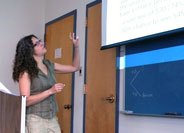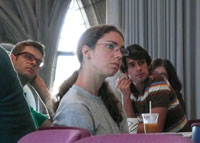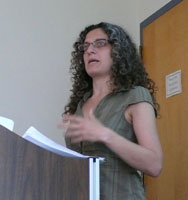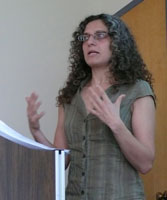::: center home >> being here >> last donut? >> frames and decisions |
Frames and Decisions Today's speaker in the lunchtime series is Natalie Gold. She is the first of this year's Visiting Fellows to speak. Her topic is framing in decision theory. I have a complete novice's head when it comes to decision theory; and this particular topic is one that always leaves it spinning. The set up is familiar. We are offered a decision, usually with profound human implications. Here is some dreadful illness and there's a treatment that manages to save 80% of those treated. Or there's a treatment whose patients are 20% likely to die. Facts like this are embedded within a complicated set of further figures and possibilities that I scramble to collect. I can feel myself mouthing silently the facts in the hope that they will penetrate my brain before the narrative has dissolved into the next slide. Is 80% surviving a better outcome that 20% dying? I feel like the student with math anxiety who has just been asked "What is the square of the square root of 37?" Could it be 37, even though 37 doesn't have a square root I know? Is that the trap? Then comes the "gotcha." Of course the two are the same. Everyone knows that, Natalie remarks, and in a way that lets us know that she knew that we knew all along. I nod and set my jaw firmly, trying to feign the body language of someone who was sure all along and did see straight through the trap. That Natalie can breeze through these examples displays her obvious comfort with complications, the very sorts of scenarios that leave me quite befuddled. That fits with the story I'd just told everyone about her, in introducing her as speaker. She may have her PhD just a few years ago in 2005 from Oxford. But her academic work has already taken her to live in more parts of the world than most people see in a lifetime. She's traveled in the US on a scholarship; had a postdoc at Duke; another scholarship at the Australian National University; a postdoc at the University of Konstanz; and then finally she was offered a lectureship at Edinburgh University. Of course, she is now spending the year here in Pittsburgh. She probably instinctively enters the "expert traveler" line at the airport security gates. While the setting may have been changing, the academic content of her interests seem to have been stable. That mirrored the topic of her talk. It is a well known effect in the psychology of decision that describing a decision differently can lead to radically different choices, even though the decision offered is identical in both cases, in all but the way it is described. These changes are changes of frame and the resulting differences in choices taken are framing effects. This is all well-known. Natalie, however, is not convinced that the basic concepts are well understood. Here she is the philosopher, demanding conceptual clarity in foundations, while others are happy to build on, perhaps with the thought that these foundations can be repaired later. The tutorial on the topic of framing is over and Natalie now turns to explication. She is concerned to define more precisely just when a framing effect occurs. Her expectation is that this occurrence will prove interesting in other areas of philosophy of social science, where similar problems may appear under different names. Natalie works through existing explications in the literature. Cases of framing are not, she decided, defined as cases in which norms dictate that one should take the same decision; or cases in which the two decision problems are given markedly different internal, mental representations. Cases of framing arise when we have two decisions that are interconvertible merely by relabeling. 80% survival is equally well labeled as 20% fatality. We no longer have a case of mere framing if the redescription introduces new information. That sounded quite right. If the new description has more information, then clearly a different decision is being taken. It fitted nicely with the examples Natalie had developed. If we break a decision into a series of cascading multi-stage decisions, it is no longer the same problem. We are getting new information that matters. Now the notion of information is a delicate one. At the informal level, it is not so easy to specify just what information may mean. Clearly the concept at issue is relevant information. So Natalie turned to a precise theory of information whose origins, I suspected, trace back to Shannon's famous analysis in signal theory. (Afterwards, Natalie corrected me. The lineage of the idea traces back to Robert Aumann, not Shannon. "You mean there's no 'p log p'? " "No," she said. "You mean no 'bits'?" "No.") Natalie called to mind a state space of possible outcomes that is partitioned into sets of outcomes. There is an increase of information if the partition becomes finer. This was satisfying in so far as it was a precise clarification of a vague notion. But then it was not entirely satisfying yet. It seemed to me that the notion called for is the vague "information relevant to the decision," but this technical notion of a finer partition seemed not quite to be doing the job. Or perhaps I was not yet grasping the line she was developing. I needed to listen more closely to what she was saying. We took our break and then turned to what proved to be a vigorous question time, in which this same issue seemed to reappear. At 1:30 pm, our immovable stopping time, I called the proceedings to a halt, with two question still in the queue. With the usual ceremony, Natalie was presented with her umbrella. The formal event was over, but the talking was not. When I left our meeting room, Natalie was surrounded by a small group, talking and pointing at images on the blackboard. John D. Norton |










